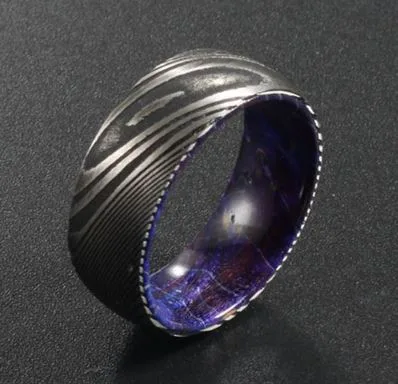Best Wedding Bands: Damascus Steel vs Other Options
When choosing a wedding band that truly stands apart, Damascus steel offers an extraordinary combination of artistry and heritage that few materials can match. This ancient metalworking technique creates mesmerizing patterns that flow across the surface like water, ensuring no two rings are ever identical. Originally forged for legendary swords centuries ago, Damascus steel now brings that same mystique and craftsmanship to modern wedding jewelry.
Despite its growing popularity, many couples remain unfamiliar with what makes Damascus steel rings special or how they compare to conventional options. Questions about durability, customization possibilities, and practical considerations often go unanswered, leaving people uncertain whether this distinctive material suits their needs. Understanding the specific characteristics, benefits, and limitations of Damascus steel wedding bands empowers you to make an informed decision that balances personal style with long-term wearability. This guide explores everything you need to know about Damascus steel rings and how they stack up against traditional wedding band materials.
Understanding Damascus Steel
Damascus steel refers to a forging technique that layers different types of steel together, creating distinctive wavy or water-like patterns across the metal’s surface. The process involves repeatedly folding and welding steel alloys at high temperatures, bonding them into a single piece with alternating layers visible on the finished product. Modern Damascus steel mens wedding band typically combine high-carbon and low-carbon steels, though craftsmen sometimes incorporate nickel or other alloys to enhance contrast and durability.
The name traces back to Damascus, Syria, where warriors prized blades made from this legendary material between 300 and 1700 AD. These swords earned reputations for exceptional strength and sharpness, with patterns believed to result from ancient forging secrets now lost to history. Contemporary Damascus steel revives this tradition through modern metallurgy, bringing centuries-old craftsmanship into today’s jewelry market.
What makes Damascus steel wedding bands truly captivating is their organic, flowing patterns that resemble wood grain, flowing water, or swirling clouds. Each ring displays a completely unique design determined by how the steel layers fold and twist during forging. The contrast between light and dark metal creates depth and visual interest that evolves as the ring catches different angles of light, offering a living piece of wearable art that traditional smooth metals simply cannot replicate.
Wedding Band Options
Traditional gold remains the most recognized wedding band material, available in yellow, white, and rose variations that suit different skin tones and style preferences. Yellow gold offers timeless warmth and requires minimal maintenance, while rose gold provides a romantic, vintage-inspired appearance through copper alloy additions. White gold delivers a contemporary silvery finish similar to platinum but at a more accessible investment level, though it typically needs periodic replating to maintain its bright appearance.
Platinum stands as the premium choice among precious metals, prized for its natural white luster that never fades and exceptional density that resists wear. This metal’s hypoallergenic properties make it ideal for sensitive skin, and its weight gives rings a substantial, luxurious feel. Silver presents an affordable alternative with similar coloring, though its softer composition makes it less suitable for everyday wear and more prone to scratching and tarnishing over time.
Beyond these classics, modern couples increasingly explore alternative materials that reflect personal interests and lifestyles. Tungsten carbide offers extreme scratch resistance and contemporary styling, while titanium provides aerospace-grade strength at remarkably light weight. Wood inlays, meteorite fragments, and dinosaur bone create conversation-starting designs for nature enthusiasts. Damascus steel bridges traditional and alternative categories, combining metallic durability with artistic patterns that rival precious metals in visual appeal. Customization possibilities vary significantly across materials—precious metals allow for intricate engraving and stone settings, while Damascus steel’s patterns can be manipulated through different forging techniques and acid etching depths to create personalized designs that remain permanently embedded in the metal’s structure rather than applied to its surface.
Size Limitations of Damascus Rings
Damascus steel rings accommodate the full spectrum of standard ring sizes, typically ranging from size 4 through size 15 to fit most finger dimensions. Reputable craftsmen maintain sizing consistency through precise mandrel measurements during the forging process, ensuring accurate fit despite the complex layering technique. The material itself poses no inherent restrictions on size availability—the steel layers bond uniformly regardless of ring diameter, allowing jewelers to create everything from delicate bands for smaller fingers to substantial rings for larger hands without compromising structural integrity or pattern quality.
Custom sizing presents more flexibility with Damascus steel than many assume, though the approach differs from traditional precious metals. Rather than cutting and soldering an existing ring to adjust size, craftsmen typically forge Damascus bands to exact specifications from the beginning, as cutting through the layered structure and re-welding can disrupt pattern continuity. This means ordering the correct size initially proves essential. For those between standard sizes or with unique finger shapes, skilled artisans can create half-sizes or even quarter-sizes during the original forging process. Some makers like Saga Bands offer finger measuring kits or temporary sizers to ensure accuracy before committing to production, eliminating guesswork that might lead to ill-fitting rings.
Comfort fit options significantly enhance wearability for Damascus steel bands, particularly for individuals unaccustomed to wearing rings daily. This design features a gently rounded interior surface rather than flat edges, allowing the ring to slide on more easily and reducing pressure points that cause discomfort during temperature changes or physical activity. The domed interior distributes contact more evenly around the finger, preventing the pinching sensation sometimes experienced with traditional flat-inside bands. Damascus steel’s moderate weight—heavier than titanium but lighter than platinum—combines with comfort fit profiles to create rings that feel substantial without becoming burdensome during extended wear, making them practical choices for active lifestyles and professions requiring frequent hand use.
Unique Textures and Patterns
Damascus steel patterns fall into several distinct categories, each created through specific folding and forging techniques. Ladder patterns feature parallel lines running across the band’s surface, achieved through straight layering and controlled etching. Raindrop or rose patterns display circular formations that resemble water droplets, created by drilling and manipulating the steel layers before final forging. Twist patterns produce diagonal or spiral flows across the ring, resulting from rotating the steel billet during the layering process. Woodgrain patterns mimic natural timber with organic, flowing lines that create an earthy aesthetic.
The tactile experience of Damascus steel adds another dimension beyond visual appeal. While the surface feels smooth to the touch after proper finishing, the metal’s depth creates subtle texture variations that catch fingertips differently than uniform metals. Acid etching enhances pattern visibility by darkening recessed layers, creating topographical interest that changes how light interacts with the surface throughout the day. Some craftsmen leave slight texture intentionally, while others polish to mirror finishes that emphasize contrast over tactile variation.
Design customization extends beyond choosing base patterns. Width adjustments alter how patterns display—wider bands reveal more intricate details, while narrower profiles create compressed, intense designs. Combining Damascus steel with contrasting materials like rose gold liners, carbon fiber inlays, or gemstone settings creates hybrid designs. Craftsmen can also manipulate acid etching intensity to produce high-contrast dramatic patterns or subtle, understated flows depending on personal preference, ensuring each ring reflects individual style while maintaining the material’s inherent uniqueness.
Making Your Damascus Steel Wedding Band Decision
Damascus steel wedding bands deliver a compelling combination of historical craftsmanship and contemporary artistry that sets them apart from conventional options. The material’s distinctive layered patterns create one-of-a-kind designs that precious metals cannot replicate, while its durability rivals modern alternatives like tungsten and titanium. Understanding the forging process, pattern variations, and customization possibilities helps couples appreciate why Damascus steel has transcended its ancient origins to become a sought-after choice for modern commitment jewelry.
Size considerations and comfort features prove less restrictive than many assume, with skilled artisans capable of creating precise fits across the full range of finger dimensions. The importance of ordering correct measurements from the start cannot be overstated, as Damascus steel’s layered structure makes post-production resizing challenging. Comfort fit profiles address wearability concerns, making these rings practical for daily wear despite their artistic complexity.
Choosing the right wedding band ultimately balances personal aesthetic preferences with practical considerations like lifestyle demands and long-term maintenance. Damascus steel occupies a unique position—offering the visual drama and individuality of alternative materials while maintaining the metallic durability and timeless appeal that traditional bands provide. For couples seeking wedding jewelry that tells a story and stands as a conversation piece, Damascus steel delivers both symbolic weight and tangible beauty that evolves with each viewing.






